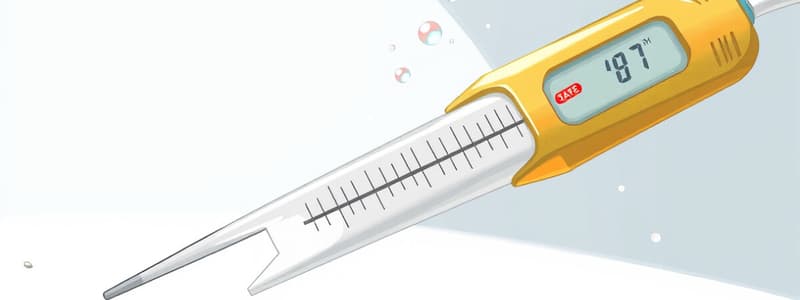Podcast
Questions and Answers
What is the flow of food?
What is the flow of food?
The path food takes in your operation from purchasing to service.
What temperature range is considered the temperature danger zone?
What temperature range is considered the temperature danger zone?
- 0F to 41F
- 165F to 180F
- 135F to 165F
- 41F to 135F (correct)
What are some ways food can be time-temperature abused?
What are some ways food can be time-temperature abused?
Handled in ways like cooked to the wrong minimum internal temperature, held at the wrong temperature, or cooled or reheated incorrectly.
How can cross-contamination be prevented in the operation?
How can cross-contamination be prevented in the operation?
What is the method for calibrating a thermometer using the ice-point method?
What is the method for calibrating a thermometer using the ice-point method?
What must be done to the cutting board after trimming raw chicken before prepping vegetables?
What must be done to the cutting board after trimming raw chicken before prepping vegetables?
How far must a bimetallic stemmed thermometer be inserted into food to give an accurate reading?
How far must a bimetallic stemmed thermometer be inserted into food to give an accurate reading?
What probe should be used to check the temperature of a large stockpot of chili?
What probe should be used to check the temperature of a large stockpot of chili?
What device can be used to record time-temperature abuse during the delivery of food?
What device can be used to record time-temperature abuse during the delivery of food?
At what temperatures do most foodborne pathogens grow most quickly?
At what temperatures do most foodborne pathogens grow most quickly?
Which type of thermometer can read temperature without touching the item's surface?
Which type of thermometer can read temperature without touching the item's surface?
A thermometer used to measure the temperature of food must be accurate to what temperature?
A thermometer used to measure the temperature of food must be accurate to what temperature?
Flashcards are hidden until you start studying
Study Notes
Flow of Food
- Flow of food refers to the journey food takes from purchasing to serving.
- Major concerns include cross-contamination and time-temperature abuse.
- To prevent cross-contamination, use dedicated equipment for different foods and ensure thorough cleaning and sanitizing of all surfaces.
Time-Temperature Abuse
- Occurs when food remains in the temperature danger zone (41°F to 135°F or 5°C to 57°C).
- Prevention includes frequent monitoring of food temperatures using thermometers.
Using Thermometers
- Place the thermometer in the thickest part of the food for accurate readings.
- A bimetallic stemmed thermometer should be inserted from the tip to the end of the sensing area.
- Wait for the reading to stabilize before recording.
Proper Thermometer Maintenance
- Thermometers must be calibrated regularly to ensure accuracy.
- Clean and sanitize thermometers before and after each use.
- Avoid using glass thermometers unless they are shatterproof.
Preventing Time-Temperature Abuse
- Time-temperature control for safety (TCS) food is abused if:
- Cooked to improper minimum internal temperatures.
- Held at incorrect temperatures.
- Not cooled or reheated properly.
Preventing Cross-Contamination
- Employ separate equipment when preparing different food types.
- Clean and sanitize surfaces and utensils after each task.
- Prep raw meat, poultry, and seafood separately from ready-to-eat foods.
- Opt for ingredients that require minimal handling.
Ice-Point Method for Calibrating Thermometers
- Fill a container with crushed ice and add cold water until full, stirring well.
- Submerge the thermometer's sensing area in the mixture for 30 seconds.
- Adjust the thermometer to read 32°F (0°C) by rotating the head while holding the calibration nut.
Cleaning and Sanitizing Procedures
- A cutting board used for raw chicken must be washed, rinsed, and sanitized before preparing vegetables.
Thermometer Usage
- A bimetallic thermometer should be inserted up to the dimple for an accurate reading.
- An immersion probe is suitable for checking the temperature of a large stockpot of chili.
Devices for Monitoring Time-Temperature Abuse
- Time-temperature indicators can be utilized to log potential abuses during food delivery.
Foodborne Pathogens
- Most pathogens proliferate quickly between 70°F and 125°F (21°C and 52°C).
Non-Contact Thermometry
- Infrared thermometers allow for temperature readings without direct contact with the surface of food.
Thermometer Accuracy Requirements
- Thermometers used for food must maintain accuracy within +/- 2°F or +/- 1°C.
Studying That Suits You
Use AI to generate personalized quizzes and flashcards to suit your learning preferences.




